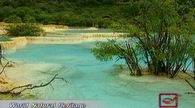 With an elevation of 5,588 meters, Xuebaoding, the summit of the Minshan Mountain Ridge, is covered by snow all the year round. It is often enveloped in mist and clouds. The Tibetans regard the summit sacred. According to local people, you can have a whole picture of the summit only in July and August. The water from melted snow provides moisture to this valley. This is the famous Huanglong Valley. It is a travertine valley that is 3.5 kilometers long and 300 meters wide. As the mountain resembles a dragon, it is also known as Hidden Dragon Mountain. With an elevation of 5,588 meters, Xuebaoding, the summit of the Minshan Mountain Ridge, is covered by snow all the year round. It is often enveloped in mist and clouds. The Tibetans regard the summit sacred. According to local people, you can have a whole picture of the summit only in July and August. The water from melted snow provides moisture to this valley. This is the famous Huanglong Valley. It is a travertine valley that is 3.5 kilometers long and 300 meters wide. As the mountain resembles a dragon, it is also known as Hidden Dragon Mountain.
The water from melted snow and the karst emerging from below the earth flow together in the Huanglong Valley. The calcium carbonate in the water concentrated to form solid travertine dikes. This gives rise to groups of colored ponds.
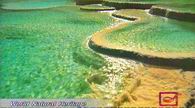 Colored travertine ponds are the main landscapes in Huanglong. Altogether Huanglong has over 2,300 colored ponds in eight groups. Different layers of ponds are joined together just like terraced fields. Large ponds are dozens of square meters, and the small ones are only a few square meters. The calcium carbonate in the ponds deposited to form travertine bodies together with organic and inorganic substances. The water in the ponds is in different colors when the sun shines on it. So the ponds in Huanglong are called five-colored ponds.
Colored travertine ponds are the main landscapes in Huanglong. Altogether Huanglong has over 2,300 colored ponds in eight groups. Different layers of ponds are joined together just like terraced fields. Large ponds are dozens of square meters, and the small ones are only a few square meters. The calcium carbonate in the ponds deposited to form travertine bodies together with organic and inorganic substances. The water in the ponds is in different colors when the sun shines on it. So the ponds in Huanglong are called five-colored ponds.
On the hillsides by the two sides of the Huanglong Valley are virgin forests. Different types of flowers and plants are found in the forests. The evergreen coniferous trees and precious flowers and plants add to the beauty of Huanglong. According to statistics, Huanglong has a forest coverage of 65.8% and a vegetation coverage of 88.9%.
Many rare animals are also found in the forests in Huanglong. Occasionally, these lovely birds visit the colored ponds.
Huanglong Monastery
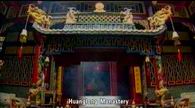 Located in the Huanglong Valley, the Huanglong Monastery was the first Taoist building in northwest Sichuan Province. It was first built during the reign of Ming Emperor Hongwu. It is now a religious place for the local Tibetan, Han, Qiang and Hui people with different religious beliefs. The annual Huanglong Monastery Fair attracts large numbers of people.
Located in the Huanglong Valley, the Huanglong Monastery was the first Taoist building in northwest Sichuan Province. It was first built during the reign of Ming Emperor Hongwu. It is now a religious place for the local Tibetan, Han, Qiang and Hui people with different religious beliefs. The annual Huanglong Monastery Fair attracts large numbers of people.
Huanglong Cave
Not far from the Huanglong Monastery is the Huanglong Cave. The cave contains different kinds of stalactites and stalagmites. It is the largest travertine cave in China. In addition, it is a natural ice cave with the longest frozen period in China.
Huanglong travertine waterfall & Huanglong Valley
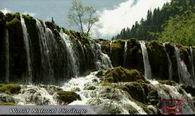 Five-colored rushing water climbs over the dyke, leaving an impressive travertine waterfall in Huanglong. The main part of travertine waterfall is 2,500 meters long and 30 to 170 meters wide. Under the sun, the calcium water slowly flows down just like golden sand. The flowing golden water makes the valley look like a golden dragon lying between the snow-capped mountain and the forest.
Five-colored rushing water climbs over the dyke, leaving an impressive travertine waterfall in Huanglong. The main part of travertine waterfall is 2,500 meters long and 30 to 170 meters wide. Under the sun, the calcium water slowly flows down just like golden sand. The flowing golden water makes the valley look like a golden dragon lying between the snow-capped mountain and the forest.
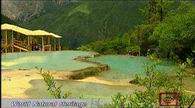 Fundamentally, the colored ponds in Huanglong came into being when limestone was eroded by water. Geologically, this is known as karst landform. In China, karst landforms are found in many areas. So why are there large colored ponds only in Huanglong?
Fundamentally, the colored ponds in Huanglong came into being when limestone was eroded by water. Geologically, this is known as karst landform. In China, karst landforms are found in many areas. So why are there large colored ponds only in Huanglong?
In China, karst topography is found mainly in Sichuan, Yunnan, Guangxi and Guizhou. The typical feature of karst topography is that limestone was eroded by water to form stone forests, rock columns, caves and underground rivers.
The Lunan Stone Forest in Yunnan Province is typical. Stone forests in Yunnan are called sword-shaped karst. Although they are entirely different from the colored ponds in Huanglong, they still fall under karst topography.
An area of 350 square kilometers in Lunan County, Yunnan Province, is full of stone forests. The forests are made of sword-shaped karst. The karst topography from Guilin and Yangshuo, Guangxi, is in the shape of a tower. These spectacular landscapes are typical karst landforms. Why are the karst landscapes in Huanglong so different from the karst landforms in Yunnan and Guangxi?
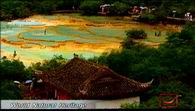 The stone forests in Yunnan and the karst landscapes in Guilin, Guangxi, were caused by limestone eroded by water. The colored bonds in Huanglong, however, were caused by the solid dikes formed by travertine deposits. Therefore, stones in Guangxi and Yunnan were eroded by water to form rock columns and stone forests. In Huanglong, however, travertine deposited in water to form colored bonds.
The stone forests in Yunnan and the karst landscapes in Guilin, Guangxi, were caused by limestone eroded by water. The colored bonds in Huanglong, however, were caused by the solid dikes formed by travertine deposits. Therefore, stones in Guangxi and Yunnan were eroded by water to form rock columns and stone forests. In Huanglong, however, travertine deposited in water to form colored bonds.
The Baishui Terrance Travertine Pond is located in Zhongdian, Deqen, Yunnan Province. The bond is very similar to those in Huanglong. The residents in Zhongdian are mostly Tibetan and Naxi people. They regard the Baishui Terrace sacred. The Naxi people have a special song about the terrace. Although the Baishui Terrace is similar to the ponds in Huanglong, it isn’t as beautiful as Huanglong. It hasn’t been listed as world natural heritage either. Why?
The Baishui Terrace in Zhongdian covers 3 square kilometers of land. The Huanglong Valley is 3.5 kilometers long. Huanglong is larger than the Baishui Terrace. Huanglong is superior to Baishui because the former is colored whereas the latter is white. What caused the great difference?
A careful observation shows that many plants such as azaleas and willows grow by the colored ponds in Huanglong. The branches of these plants have long been immersed in the water. As a result, the water is covered by travertine and algae. The minerals in travertine and algae combine to make the water appear in blue, yellow and green. Thanks to the beautiful water, Huanglong appears to be gorgeous against the snow-capped mountains and forests nearby. The Baishui Terrace, however, doesn’t have so many plants by the pond as Huanglong does. There aren’t any forests around Baishui either.
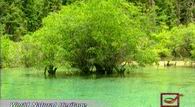 In the world, large-scale travertine caused by deposited cold water is very rare. Just like Huanglong, Turkey’s Herablis also has large colored ponds. But these ponds are not so big as those in Huanglong either individually or as a whole. An individual colored pond in Huanglong has an outside vertical height of 6.8 meters and is the highest in the world. And it is 3.5 kilometers long. Huanglong has 2,331 colored ponds which constitute the largest such landscape in the world.
In the world, large-scale travertine caused by deposited cold water is very rare. Just like Huanglong, Turkey’s Herablis also has large colored ponds. But these ponds are not so big as those in Huanglong either individually or as a whole. An individual colored pond in Huanglong has an outside vertical height of 6.8 meters and is the highest in the world. And it is 3.5 kilometers long. Huanglong has 2,331 colored ponds which constitute the largest such landscape in the world.
As Huanglong, the Baishui Terrace and Shilin have different geological structures, they have different landscapes. For example, in Shilin, large granites were seriously eroded by rainwater for hundreds of millions of years, and they are right there before your eyes. Close to Shilin is a lake called Yangzong. The water there is blue, and you can see gray substance in the blue. The gray substance is dissolved calcium. It cannot form travertine because the flow and the speed are great. So there are only eroded stones left. Things are different at the Baishui Terrace and the Huanglong Valley. Rainwater or water from melted snow gradually infiltrates into the mountains. The mountains are composed of limestone. The water emerges from the mountains as spring. The mountain slopes at the Baishui Terraceand the Huanglong Valley are not steep. The flow is not great either. So the calcium dissolved in water built up layer by layer to make the travertine ponds at the Baishui Terraceand the Huanglong Valley.
Huanglong is in Songpan, an area full of hills and lack of roads. But this is the only way between the hinterland and the prairie. Since ancient times, businessmen have been using this rugged mountain path.
Songpan
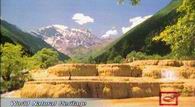 The county seat of Songpan is the center of the area. Up till now Songpan has been the largest fair on the borders of Sichuan, Gansu and Qinghai.
The county seat of Songpan is the center of the area. Up till now Songpan has been the largest fair on the borders of Sichuan, Gansu and Qinghai.
The ancient city of Songpan was first built in 1378. It took 60 years to complete. Although the city was ravaged by long wars in history, we can still feel its magnificence from the remaining thick walls and tall gates.
Songpan, including Huanglong, is home to people of the Tibetan, Han, Qiang and Hui nationalities. But the main residents here are Tibetans. According to experts, they began to live here over 2,000 years ago. They raise yaks and grow high barley.
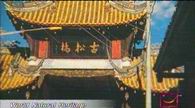 The residents here believe in Buddhism. Both monks and ordinary villagers can recite Buddhist scriptures. Buddha statues are hand made with high barley powder. They are replaced by new ones once every fortnight.
The residents here believe in Buddhism. Both monks and ordinary villagers can recite Buddhist scriptures. Buddha statues are hand made with high barley powder. They are replaced by new ones once every fortnight.
Having finished work for the day, they come home in the evening to enjoy their dinner with buttered tea and high barley cakes. They lead a simple but fulfilling life. People do the harvesting. They sing a song to thank the earth and nature.
Huanglong has always had an important position in local Tibetans. They regard Xuebaoding “sacred peak” and call the Huanglong Valley “sacred water.” On every June 15 of the Tibetan calendar, Tibetans in Huanglong and elsewhere pay homage to this sacred peak of Xuebaoding.
 Since a very long time ago, the residents here have been coexisting with rivers and mountains. They enjoy what nature has for them. They do not stop praying here even in cold winter. They even climb to the top of the snow mountain to say their prayers.
Since a very long time ago, the residents here have been coexisting with rivers and mountains. They enjoy what nature has for them. They do not stop praying here even in cold winter. They even climb to the top of the snow mountain to say their prayers.
It is spring now. The water in the Huanglong Valley is flowing endlessly and vigorously. South of the Huanglong Monastery are a stone tower and a small temple. They were built in 1620. About two meters of them are covered by travertine. According to experts, travertine deposits are increasing by three millimeters a year. Geologically speaking, Huanglong is still full of vigor as it is growing everyday.
|